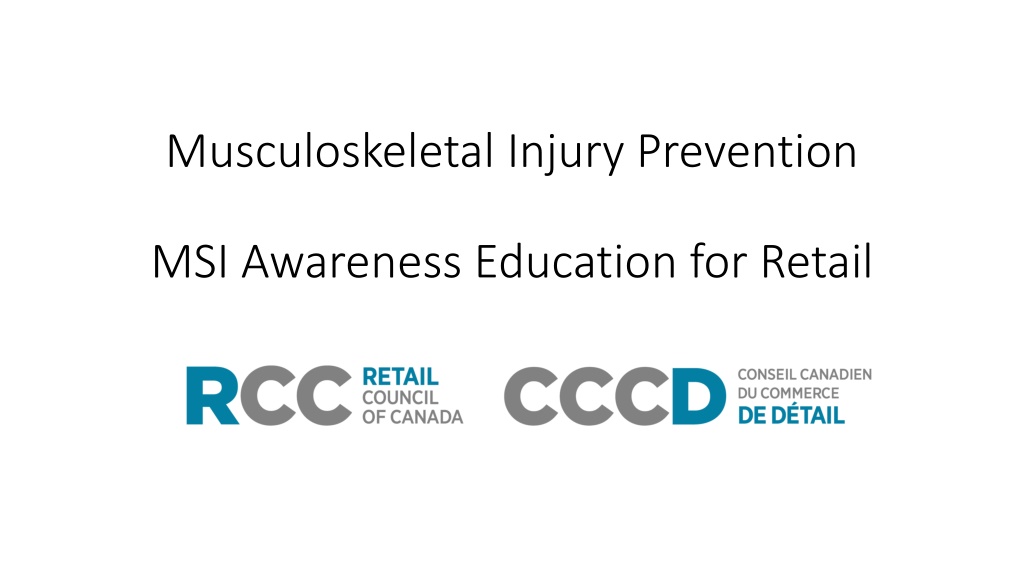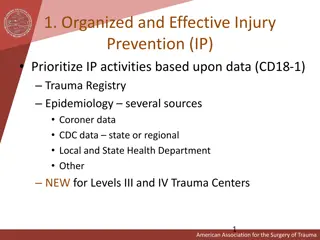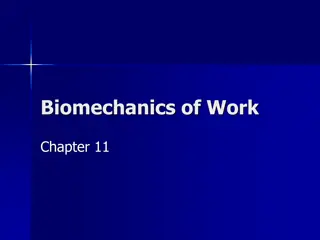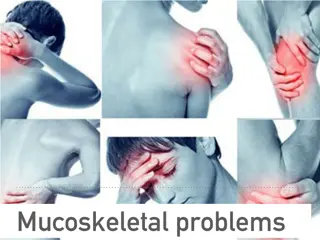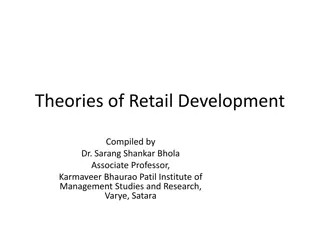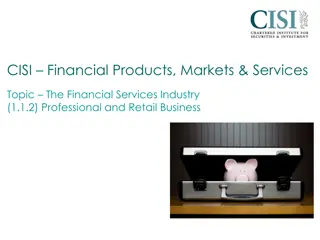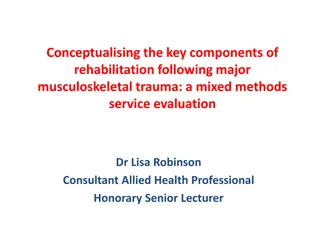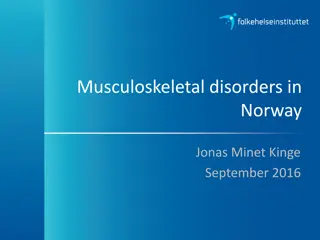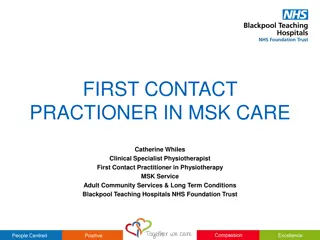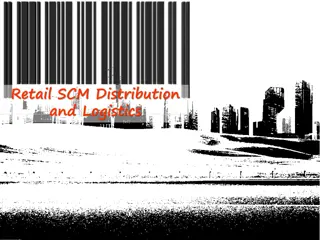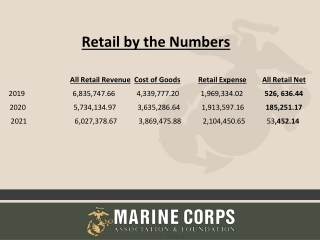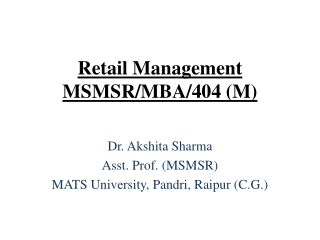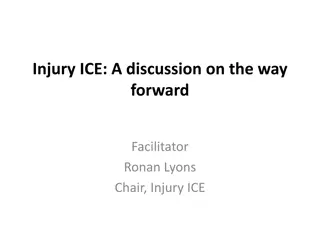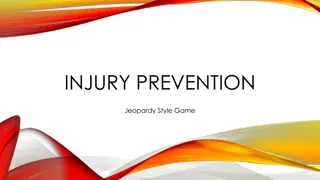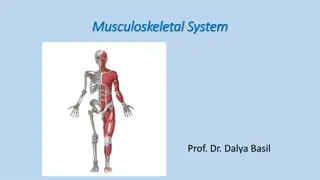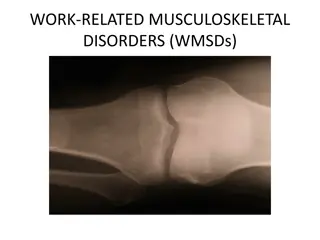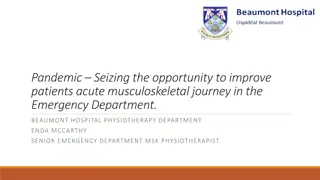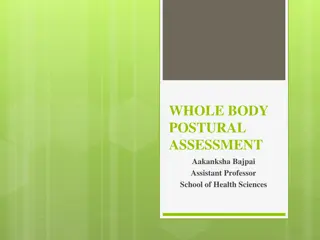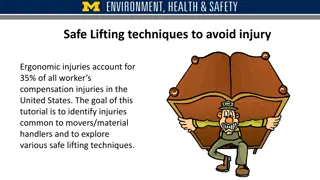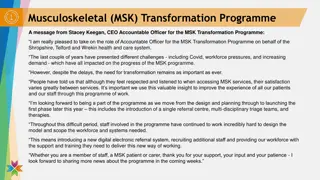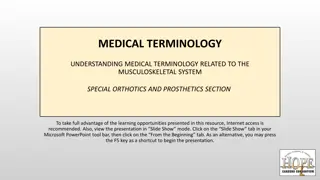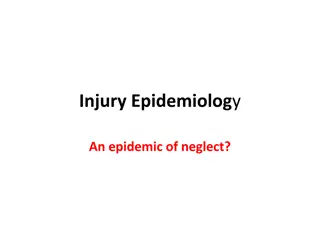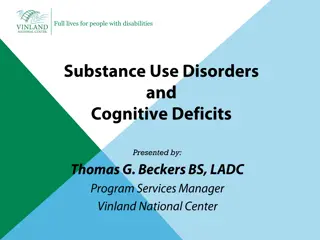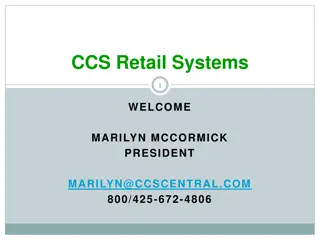Musculoskeletal Injury Prevention in Retail: Awareness and Education
This educational content focuses on Musculoskeletal Injuries (MSI) in the retail sector, explaining what MSI is, responsibilities of employers and employees, early signs and symptoms of MSI, and what to do when experiencing MSI concerns. It emphasizes creating a safe workplace, recognizing MSI hazards, reporting symptoms, and seeking medical help when needed.
Download Presentation

Please find below an Image/Link to download the presentation.
The content on the website is provided AS IS for your information and personal use only. It may not be sold, licensed, or shared on other websites without obtaining consent from the author. Download presentation by click this link. If you encounter any issues during the download, it is possible that the publisher has removed the file from their server.
E N D
Presentation Transcript
Musculoskeletal Injury Prevention MSI Awareness Education for Retail
What are MSI? MSI are soft tissue injuries that are caused or made worse by work MSI may be caused by a single event For example, straining a muscle during heavy lifting MSI may be caused by the effects of multiple repeated events For example, tendonitis from repetitive awkward wrist movements
The Employer is responsible for... A healthy and safe workplace, including minimizing the risk of MSI; A Health and Safety Committee [or safety representative] that meets monthly; Recording and tracking MSI and MSI concerns of employees; Preventing MSI by identifying and controlling MSI hazards in the workplace; Training all employees to understand MSI hazards and controls in their work.
Rights and Responsibilities as an Employee Employees have a right to: A safe and healthy workplace; Be trained in safe work practices and recognition of hazards in your work Employer-provided safety equipment (except safety footwear and headgear) Refusal of unsafe work that presents undue risk of injury. Employees have a responsibility to: Report MSI signs, symptoms, or concerns to their supervisor and/or safety representative; Participate in MSI prevention activities, including the identification of MSI hazards and controls in their work; Participate in MSI prevention education regarding MSI hazards and controls; Perform work according to safe methods prescribed by the employer for MSI.
Early Signs and Symptoms of MSI Signs can be seen, including: swelling, redness, bruising, or limited ability to move. Symptoms cannot be seen but are felt, including: pain, aching, tingling, numbness, fatigue or loss of strength. Signs and symptoms may begin gradually or may occur suddenly. Signs and symptoms may be noticed during work or at home. Early signs and symptoms indicate possible MSI that may worsen if there is no change in how work is performed.
What to do if you have MSI signs, symptoms or concerns Don t ignore it or attempt to just work through it . The earlier you respond to signs and symptoms, the better. Report signs, symptoms or concerns to your supervisor and/or safety representative as soon as you become aware of them. Review information about MSI hazards and controls in your work. Look for things in your work that may make it worse (MSI hazards). Look for ways to work that protect your body and minimize exposure to things that make it worse (MSI controls). Seek medical assistance if signs and symptoms are severe, getting worse, or not improving.
Health Effects Common MSI Tendonitis Carpal Tunnel Syndrome (nerve entrapment disorders) Low back pain
Tendonitis Tendons attach muscle to bone Overuse/Repetitive Strain over time or high force overexertion incident Signs and symptoms include pain, swelling, loss of strength or range of movement Damage to tendons in the thumb, hand, wrist, elbow, shoulder result from: Forceful gripping (whole hand or fingertip pinch grip) Awkward postures of the fingers, wrist, elbow or shoulder Repetitive gripping or movements Sustained force or awkward postures
Nerve Entrapment Nerves transmit information between our brain and tissue. Nerves may become trapped or irritated at joints or at narrow passages that they pass through. Carpal tunnel syndrome (wrist), thoracic outlet syndrome (shoulder) are two common types. Referred symptoms that occur downstream from the injury are common: pain, numbness, tingling, burning or weakness in the hand or fingers may occur from nerve irritation at the wrist, elbow, shoulder or neck. Risk factors are the same as those for tendonitis plus contact pressure.
Low Back or Neck Injury Low back or neck injury may involve similar symptoms as those experienced during tendonitis or nerve entrapment: pain or weakness in the back or neck, but may also referred symptoms. Low back referred symptoms are often in the legs or feet. Neck referred symptoms are often in the shoulders and arms. Risk factors Forceful exertion (lifting, pushing, pulling or carrying) Awkward postures of the back or neck (bending, twisting), or arms (reaching) Repeating or sustaining forceful exertion and/or awkward postures. Prolonged sitting or standing without movement
MSI hazards What to watch for in your work MSI are more likely to occur when work involves: Forceful exertion Awkward postures Repetitive movements or forceful exertions Sustained awkward postures or forceful exertion Contact pressure Risk is higher when: Single hazards are severe or large The duration of exposure is long (more hours = more risk) More than one hazard exists at the same time
Reducing MSI Risk Controlling MSI Hazards Take the time to set up your work Understand how to use the equipment provided Follow directions for preferred technique and use of risk controls Ask for assistance if unsure or if you have concerns Aim to: Minimize forceful exertion Work in neutral postures Take scheduled breaks and build rest into repetitive tasks Be aware of your body and respond to early signs or symptoms of MSI
Hazard: Forceful Exertion Lifting, Pushing, Pulling, Carrying Gripping IMAGE OF STOCKING SHELVES IMAGE OF LIFTING IMAGE OF GRIPPING PRODUCT Higher risk if: Heavy, unstable or awkward loads Reaching forward, up, down, or to one side Unable to use two hands Unable to use a whole hand grip Repetitive or sustained effort
Controlling Risk: Forceful Exertion Use equipment provided such as dollies, carts, hand-trucks Break large loads into smaller loads to reduce force Use full-hand power grip rather than finger pinch grip Adjust work area for neutral postures and no reaching Use good movement technique Ask for assistance IMAGES
Hazard: Awkward Postures Reaching, bending, twisting IMAGES reaching (high/low shelves shoulder/back), gripping (wrist)
Controlling Risk: Awkward Postures Set up work to fit you and to fit the task Target working height near elbow height Target reaches to be within forearm reach Position yourself to minimize awkward postures IMAGES Check stand Stocking cart
Hazard: Repetitive Motions Using the same body part repeatedly or sustaining effort without rest E.g., stocking shelves, folding clothing, checkout IMAGE Check stand or folding or stocking
Controlling Risk: Repetitive Motions Warm-up and Stretching Rest breaks and micro-breaks Vary tasks or share work Switch hands or use both hands
Hazard: Contact Pressure Leaning against edges Kneeling on hard surfaces Small handles (e.g., buckets with wire handles) Hard or square edges on handles Using your hand or body parts to hammer objects IMAGES Forearm on counter edge Fingers on wire handle Pricing gun
Controlling Risk: Contact Pressure Adjust working height to avoid leaning on edges Padding on edges, handles or hard surfaces Gloves to pad hands Knee pads for kneeling Avoid using body parts as a hammer get a hammer IMAGES
Preferred Technique for Manual Lifting Square and close to the load Two-hand grip Tighten abdominal muscles Stick your bum out and keep your head up (protect back posture; use leg muscles) Move smoothly at a controlled pace (avoid rapid movements) Move feet rather than twisting. Plan for lifting between mid-thigh and chest. IMAGES
Other risk factors and ideas for risk control Risk Factors Ideas for Risk Control Keep body, arms & hands warm Drink fluids, increase breaks Clean up all spills or wet zones Headlamp for dark; blinds for bright; maintain lighting Learn how to safely perform new work ask for assistance if needed Take scheduled breaks Use additional caution if working longer shifts Cold (e.g., refrigerated zones) Hot (e.g., bakery, summer) Uneven or slippery flooring Poor lighting shadow or glare Unaccustomed or new work Extended shifts or overtime
TO BE ADDED FOR SPECIFIC COMPANY/JOB Hazards specific to work Controls specific to work How to adjust workstations Use of equipment
Summary Preventing MSI Pay attention to early signs and symptoms of MSI, and your prior injuries Look for MSI hazards in your work: force, posture, repetition, contact pressure, other factors Understand and use MSI risk controls that are provided Set up your work to minimize MSI hazard severity and duration of exposure to higher risk activities Request assistance from your supervisor if you: have MSI signs or symptoms, have concerns about MSI risk, are unsure about any aspect of your work or the equipment used.
